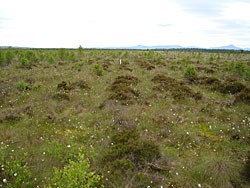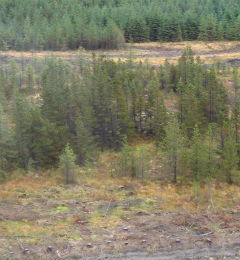Summary
Summary
 We aim to learn how land use affects the main ecosystem services from afforested peatland (i.e. water supply, flood reduction, climate change reduction, wood production and wildlife habitats). We are comparing forestry with forest-to-bog restoration and creation of low-density peatland edge woodland.
We aim to learn how land use affects the main ecosystem services from afforested peatland (i.e. water supply, flood reduction, climate change reduction, wood production and wildlife habitats). We are comparing forestry with forest-to-bog restoration and creation of low-density peatland edge woodland.
Research objectives
For the three land uses:
- Measure water yield, quality, and high and low flows
- Measure carbon in drainage water and greenhouse gas exchange with the atmosphere
- Measure the abundance of plants and animals dependent on peatland habitats
- Study microbial processes in peat, relating land use to water and greenhouse gases
- Express results in terms of the balance of ecosystem services
Status
Project work gets underway in October 2016 with 3 related PhD studentships focused on how different ecosystem services are affected by peat land use. After these finish in 2020, Forest Research will continue monitoring through land use changes.
Contact
Funders and partners
- Core funding: Forestry Commission (FC)
- PhD on water-based ecosystem services: FC Scotland, University of Leeds, FC, SEPA
- PhD on gas-based ecosystem services: FC Scotland, University of Aberdeen, James Hutton Institute, FC
- PhD on microbial processes in peat: FC Scotland,
Forestry Commission policy
Forestry policy relating to peatland habitats was set down in 2000. It encouraged only limited restoration because evidence of benefits was lacking.
In 2014, supplementary guidance for Scotland stated a presumption to restore habitats in protected sites, those affecting connectivity of EU Habitats Directive Annex 1 habitats and those where deforestation would reduce net greenhouse gas emissions. Elsewhere, on sites insufficiently productive for tree growth to compensate for greenhouse gas losses from the soil, it recommends creating low-density, low-intensity, ‘peatland edge woodland’, which retains some woodland benefits but avoids a net carbon loss. ‘Deciding future management options for afforested deep peatland’ gives more information.
The results of this research project will inform future review of the policy.
Creating sustainable forested peatlands
Summary

This PhD studentship project explores relationships between tree density and both biodiversity and greenhouse gas balance for low-density woodlands on deep peat. Its purpose is to find out more about the potential of converting afforested peatlands to ‘peatland edge woodlands’ to provide biodiverse habitats while at the same time helping to reduce climate change. By studying bogs with natural, semi-natural and planted woodland with a range of tree densities, the project aims to further our understanding of the benefits and trade-offs involved.
Research objectives
- Compare plant biodiversity of peatland along woodland density gradients.
- Compare greenhouse gas fluxes of peatlands along woodland density gradients.
- Compare carbon stock of peatlands along woodland density gradients.
- Identify any critical thresholds of woodland density for biodiversity and carbon sequestration/storage capacity.
Status
The project started in October 2017 and runs until September 2021. It is being undertaken mainly by PhD student Will Jessop, based at the University of York.
Contact
Will Jessop or Russell Anderson
Funders and partners
The project is a partnership between Forest Research, University of York, University of the Highlands and Islands and Scottish Natural Heritage. The project is funded by NERC industrial CASE studentship NE/P008925/I from the National Productivity Investment Fund, with supervisors’ time funded by the partners.
Forestry Commission Policy
Forestry policy relating to peatland habitats was set down in 2000. It encouraged only limited restoration because evidence of benefits was lacking.
In 2014, supplementary guidance for Scotland stated a presumption to restore habitats in protected sites, those affecting connectivity of EU Habitats Directive Annex 1 habitats and those where deforestation would reduce net greenhouse gas emissions. Elsewhere, on sites insufficiently productive for tree growth to compensate for greenhouse gas losses from the soil, it recommends creating low-density, low-intensity, ‘peatland edge woodland’, which retains some woodland benefits but avoids a net carbon loss. ‘Deciding future management options for afforested deep peatland’ gives more information.
Related pages
General Content
What’s of interest
New project: Creating sustainable forested peatlands
Recent book: Peatland Restoration and Ecosystem Services
Project in progress: Carbon accumulation and loss in afforested peatlands
Peatbog restoration trials: Rewetting cracked peat
Forestry policy for peatland habitats in Scotland
Peatland restoration resources
